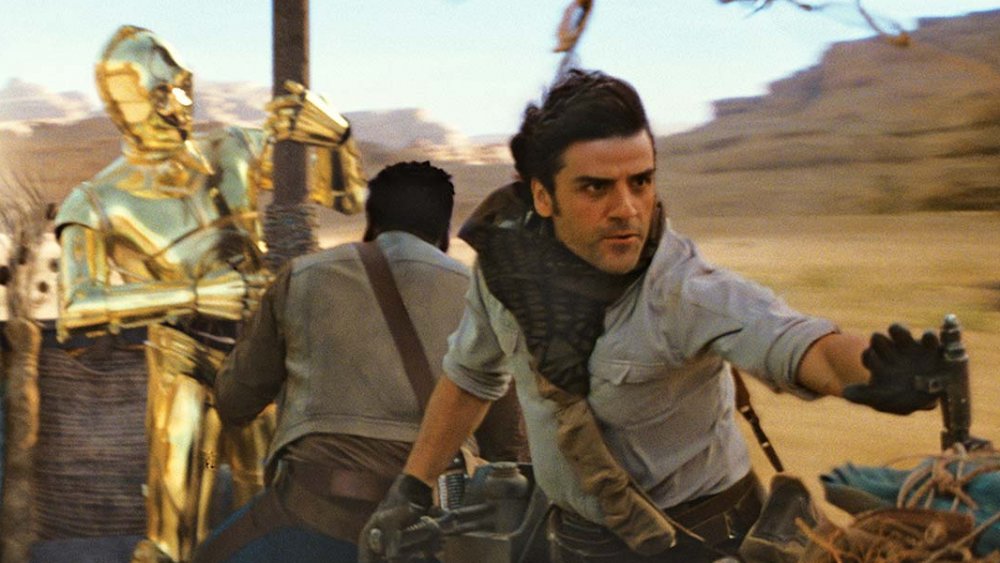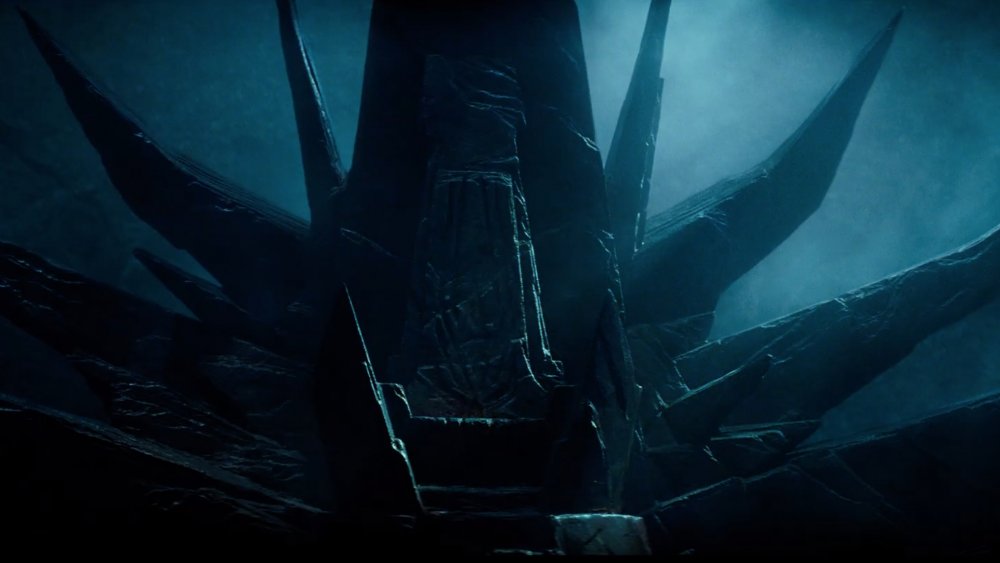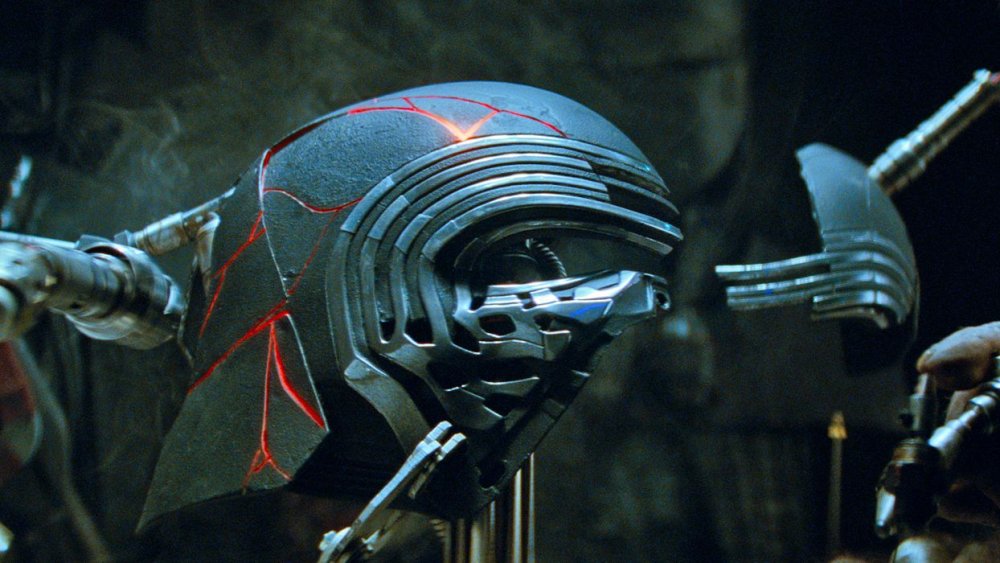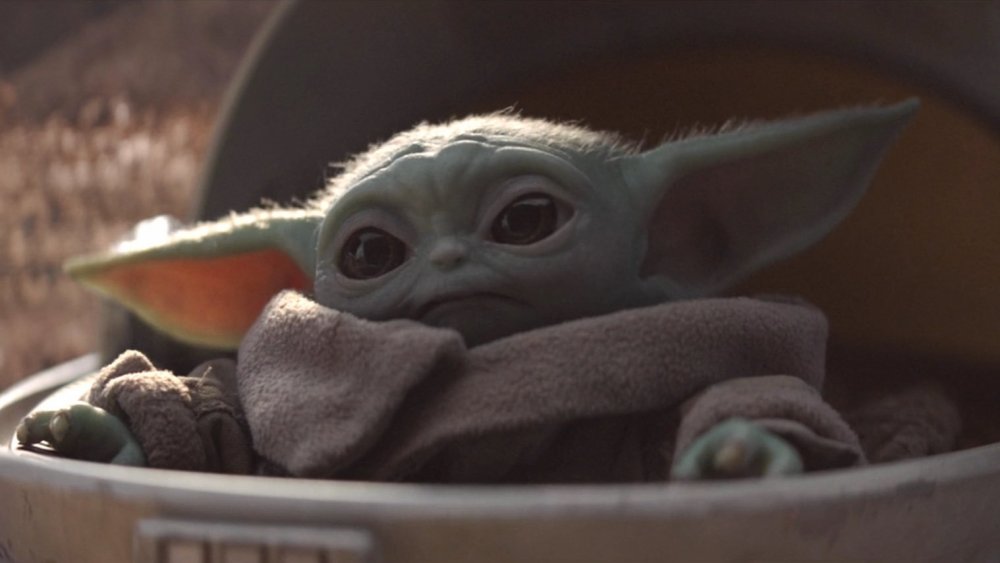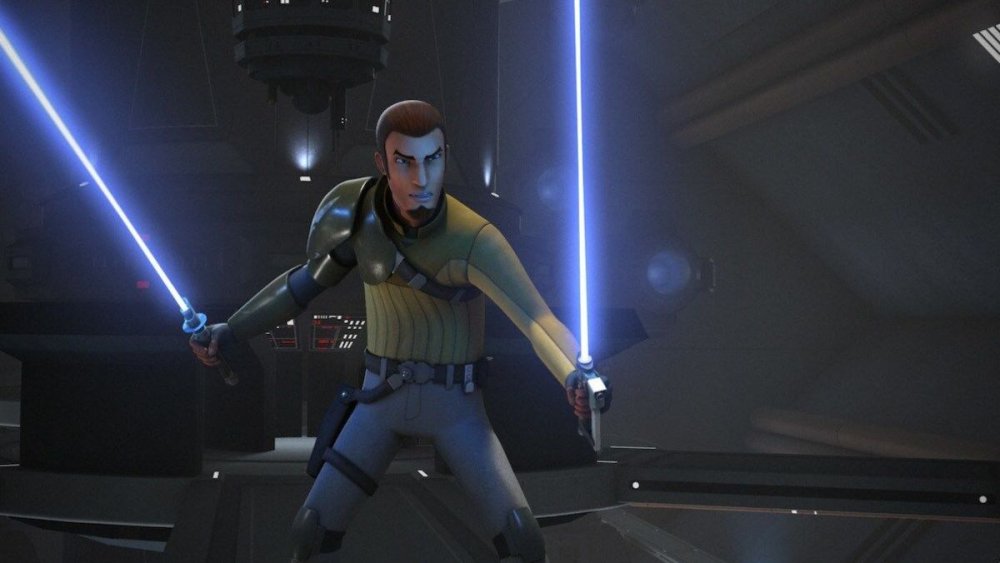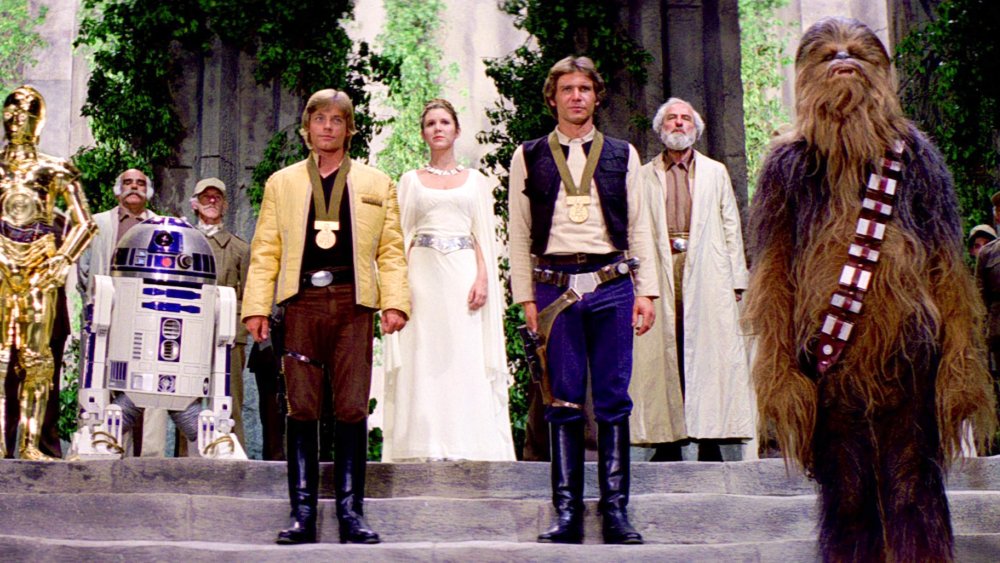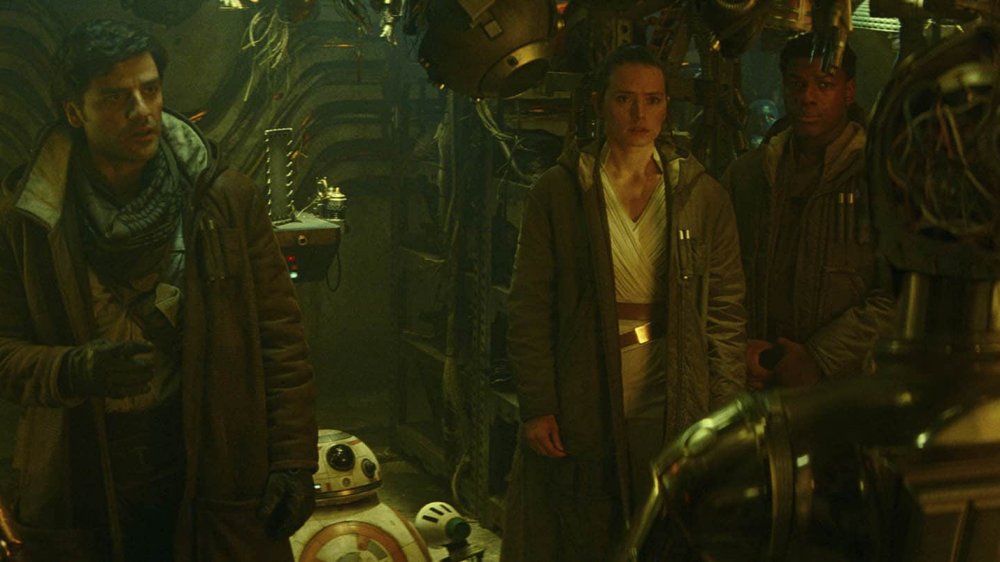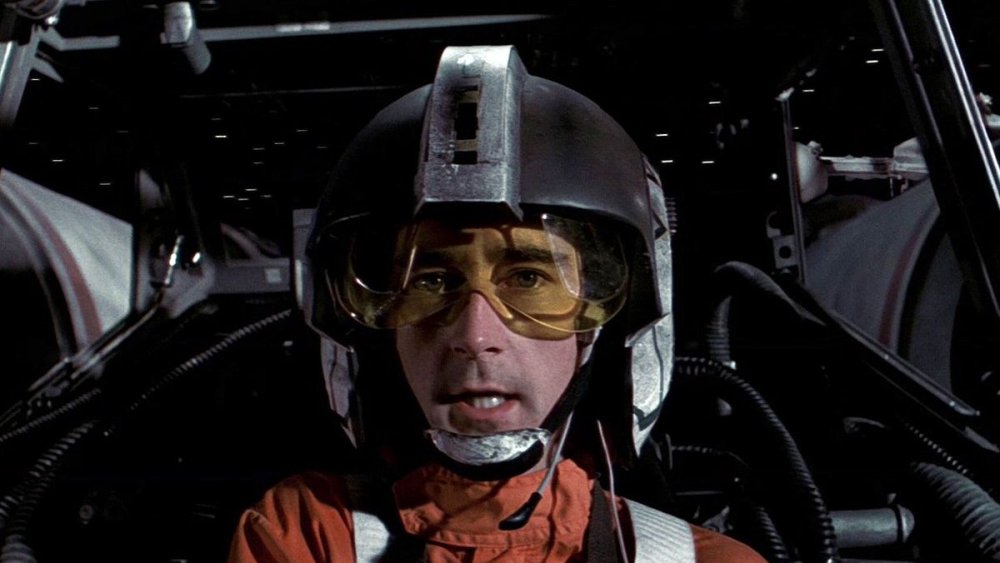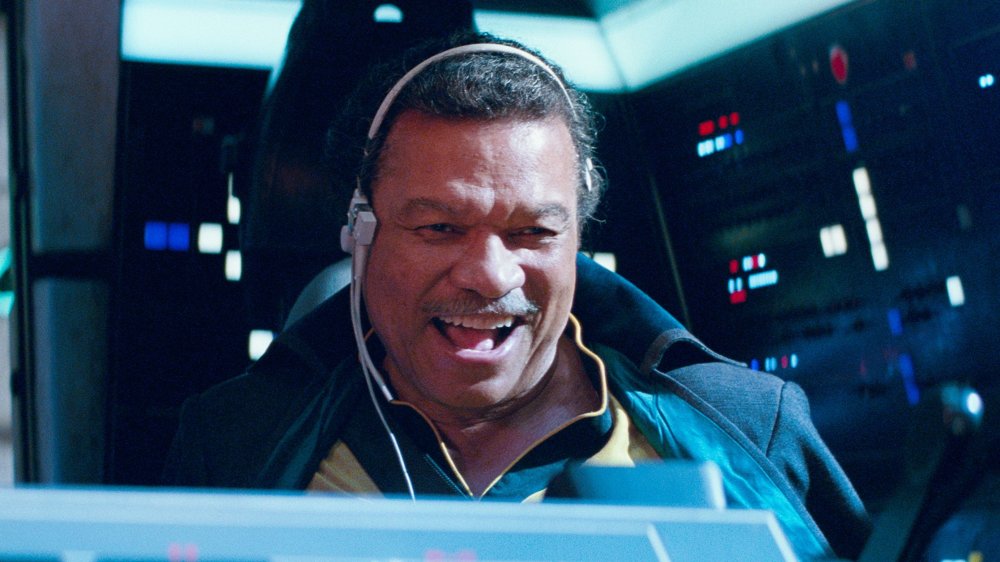Easter Eggs You Missed In The Rise Of Skywalker
It's finally here: The ninth installment in the epic Skywalker saga that started a long, long time ago in our galaxy with 1977's Star Wars: Episode IV: A New Hope. The Rise of Skywalker pulls from all three trilogies — including a touch from the much-maligned prequels — and beyond in an attempt to put a shiny bow on one of the most successful and beloved film franchises of all time.
But with so much happening up on the big screen, there were probably more than a few cool hidden details you missed. Casual fans would need a wayfinder of their own to track down all this cool stuff, considering just how much Lucasfilm history is being nodded to in nearly every scene. For Star Wars mega-fans too emotional to notice all this tucked-away treasure, here's a look at a few of the Easter eggs you might have missed in The Rise of Skywalker.
The Emperor's new-ish throne
Emperor Palpatine looks pretty rough post-resurrection in The Rise of Skywalker, and understandably so, but his majestic throne is a different story. Palp's craggy chair, "The Throne of the Sith," is the coolest bad guy seat outside of Game of Thrones, and there's a good reason for that. Concept art legend Ralph McQuarrie, the man largely responsible for the look of the original Star Wars trilogy, designed it in the '80s for Return of the Jedi.
Lucasfilm creative art manager Phil Szostak revealed this unused throne room art on Twitter back when the final Rise of Skywalker trailer dropped, posting McQuarrie's old sketches next to Palpatine's new throne. McQuarrie passed away in 2012, and his obituary in the Guardian notes that "fewer of his ideas made the cut" in Return of the Jedi, and that the Academy Award winner wasn't as enthusiastic working on the 1983 film as he was the previous two installments. So it's cool to see J.J. Abrams and his creative team revive McQuarrie's work and put it to excellent use in The Rise of Skywalker.
Kylo's kintsukuroi
Diehard fans know that Darth Vader's helmet, designed by Ralph McQuarrie, was inspired by samurai armor, and J.J. Abrams made it clear to Entertainment Weekly in 2015 that his grandson's helmet is "meant to be a nod to [Vader's]," in case that wasn't obvious enough. Kylo Ren's helmet, smashed unceremoniously by its owner in The Last Jedi, is back in The Rise of Skywalker, but only after some repairs that also evoke a centuries-old Japanese tradition.
In Skywalker, an unnamed ape-like creature restores Ren's helmet using a technique similar to kintsukuroi, or "golden repair." Kintsukuroi is all about embracing flaws as aesthetic features, and typically involves repairing broken pottery using visible gold seams. In Rise of Skywalker, Ren's helmet is reforged using a red material of some kind, but the idea is the same. Rather than make the helmet repair seamless, the red becomes part of the new design.
Abrams confirmed that kintsukuroi was the inspiration for Ren's Rise of Skywalker helmet in an interview with Empire. "Having [Kylo Ren] be masked, but also fractured, is a very intentional thing. Like that classic Japanese process of taking ceramics and repairing them, and how the breaks in a way define the beauty of the piece as much as the original itself," Abrams said. "As fractured as Ren is, the mask becomes a visual representation of that. There's something about this that tells his history. His mask doesn't ultimately hide him and his behavior is revealed."
The Disney+ connection
When Rey uses her Force powers to heal the underground sand snake on Pasaana, thus ensuring a safe exit for Episode IX's heroes, it was surely a surprise to casual fans of the Skywalker saga. We've seen the power of the Force do some pretty insane stuff, but it's mostly used for telekinesis and "mind tricks" — at least in the eight films leading up to The Rise of Skywalker. In the Extended Universe, Force healing is definitely a thing, but Episode IX is (arguably) the first big-screen depiction of the Force being used in such a manner.
The small screen, however, is a different matter. Baby Yoda attempts to heal Mando in Chapter 2 of Disney+'s The Mandalorian, but is inadvertently stopped just short of doing so. In Chapter 7, however, released on the streaming service the day before Skywalker hit theaters, everyone's favorite 50-year-old baby heals Bounty Hunters' Guild head Greef Karga after he's scratched up and poisoned by pterodactyl-like creatures on the lava-spewing planet Nevarro. Like the sand snake in Skywalker, Karga is so grateful that he decides to let our heroes escape with their lives. Fans of The Mandalorian likely perked up when they saw Rey (and later Kylo Ren) pulling off the same miraculous trick — a neat reward for those who caught the episode the day before.
Voices from the past
After Ben Solo gets chucked into a seemingly bottomless pit by Emperor Palpatine — just like Anakin did to Palpatine in Episode VI! — a devastated Rey, who still has the Emperor and his deadly Force lightning to contend with, meditates and hears several voices. There's no way those voices are just random, of course, and some are obvious, but in the chaos of the big final battle it was probably hard to make all of them out.
If you stick around and watch the credits, it all becomes clear. The voices are listed as "Voices of Jedi Past" and include some no-brainer picks (Anakin, Obi-Wan, Yoda, Qui-Gon Jinn, Mace Windu) and some head-scratchers. Here's a quick rundown of the more obscure ones: Adi Gallia (Angelique Perrin) first appeared in The Phantom Menace, but most fans know her best from the animated Star Wars: The Clone Wars series. Similarly, Luminara Unduli (Olivia D'Abo) and Aayla Secura (Jennifer Hale) first appeared in Attack of the Clones, but are best known from Clone Wars (which is likely why we hear the Clone Wars voice actors, not the live-action Attack of the Clones actors). Ahsoka Tano (Ashley Eckstein) is also from Clone Wars, but The Rise of Skywalker is the character's live-action debut, technically, even if we only hear her voice. Same goes for Kanan Jarrus (Freddie Prinze Jr.) from Star Wars Rebels (pictured above).
Better late than never
The Rise of Skywalker ends with the heroes of the new trilogy celebrating in much the same way the original trilogy's heroes did in Return of the Jedi, prefaced with much intergalactic fanfare. But this time around, one overlooked Wookie finally gets the gold.
In arguably the most blatant example of fan service in the film, Chewbacca, who famously did not get the same recognition as the humans during the Royal Award Ceremony in A New Hope, gets a medal from Maz Kanata in The Rise of Skywalker — and it's not just any medal. It's heavily implied that this award, which Leia clutches as she passes away, is the one Han received in A New Hope.
In that first Star Wars installment, you'll remember, Chewie stands quietly in the background while Princess Leia hangs medals on Han and Luke. His untranslated cry is the last sound you hear in the film, and for Chewie fans, it might as well have been subtitled, "What about me?" Fan service or not, there's no denying that the big lug deserved it, considering all that he's been through.
Cool planet, cool name, cool cameo
In Rise of Skywalker, the snowy planet of Kijimi (R.I.P.) plays a key role in the adventure as the home planet of Zorii Bliss, who ultimately helps get C-3PO to Babu Frik, the cute alien dude who hacks his programming in order to translate the Sith dagger. So what's with the name "Kijimi"? Well, thanks to one observant Redditor, we know that it's the name of a synthesizer manufactured by Black Corporation, a Japanese company who counts Skywalker director J.J. Abrams as a huge fan. He's appeared a few times on their Instagram feed, including once with Poe Dameron actor Oscar Isaac and once by himself, holding up the Kijimi synth.
So it makes sense that legendary composer John Williams, fresh off his ninth and probably final Star Wars composing gig, appears in a brief cameo on the synth-inspired planet. It's a quick, blink-and-you-miss it moment, but he's there, wearing a futuristic monocle and shaking his head at our heroes as they enter the droidsmith's shop. Bonus fun fact: His character's name is "Oma Tres," an anagram of "Maestro."
They worked in Wedge
X-wing pilot Wedge Antilles was one of the heroes of The Battle of Yavin in A New Hope, narrowly surviving the daring attack on the Death Star 1.0. He appeared again in The Empire Strikes Back and Return of the Jedi, but The Rise of Skywalker marks his first appearance in the new trilogy. Actor Denis Lawson reprises the role in a brief cameo in the final battle — praising Lando's aim, to boot! — but it sounds like he needed some convincing.
In 2015, Lawson told The Courier that he was offered a role in The Force Awakens, but, believe it or not, he flat-out turned it down. When asked about the potential gig at a screening for The Machine, Lawson told a reporter he had no interest in the role whatsoever. "I'm not going to do that," the Scottish actor said. "[Disney] asked me but it just would have bored me." We can't say for sure at this time what convinced Lawson to don Wedge's uniform once again for Skywalker, but our guess is that Disney was perhaps a bit more generous with the galactic credits, if you catch our drift.
Easter egg grab bag
As befitting the ninth film in an epic saga, The Rise of Skywalker is positively packed with nods to past installments, some a bit less significant than others, but still cool. Among the many mini-Easter eggs and callbacks hidden within: Rey's yellow lightsaber at the end. Clone Wars and Rebels feature ones of that hue, and there's an old official toy saber that's yellow, but it's the first of its kind in the Skywalker saga. Also, Ben and Han's implied "I love you/I know" exchange is a callback to the famous Han and Leia scene in The Empire Strikes Back, of course.
There's so much more: C-3PO's line about the Aki-Aki celebration only happening "every 42 years" is a sly reference to the fact that when The Rise of Skywalker was released, A New Hope was 42 years old. Lando's blaster is the same model as the one he used in Solo, which is a neat detail. The "Holdo Maneuver"? A reference to Vice Admiral Holdo's daring trick in The Last Jedi. We could go on and on.
